Most food preservation articles that get published in food microbiology journals refer to industrial processes. On occasion, I’ll come across a paper that addresses a very applied sort of problem. Such is this paper from the December 2021 issue of Food Microbiology.
As we noted in class, Salmonella can sometime persist in flour and other ingredients used in cookie recipes. The question they asked was whether normal baking conditions, like those used in one’s home kitchen, would be sufficient to inactivate Salmonella. They made two types of cookies, soft, cooked at a lower temperature for a longer time, and hard, cooked at a higher temperature for a shorter time. Both were effective.
We’ll start our discussion on the kinetics of heat inactivation on Wednesday, but this very similar to how milk is pasteurized, what we call High Temperature-Short Time (HTST) and Low Temperature-Long Time (LTLT). Indeed, it might seem counter intuitive, but we will learn that two different processes can be kinetically identical.

